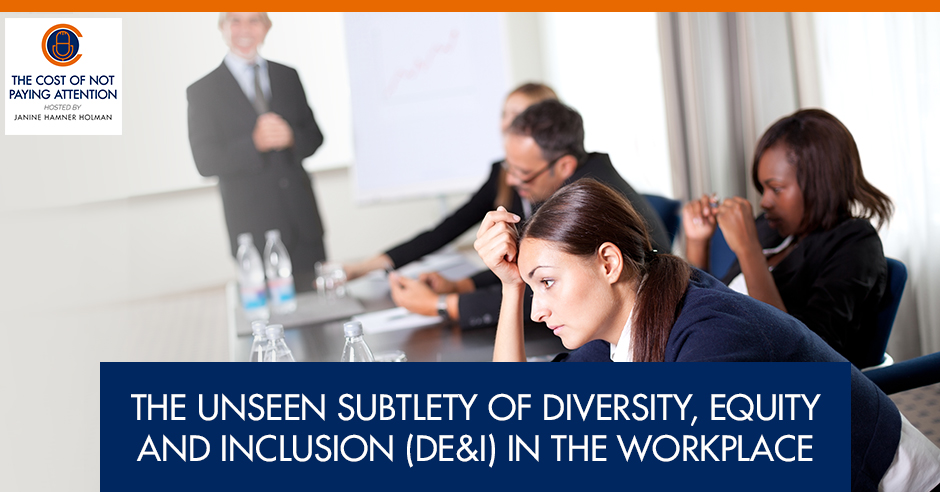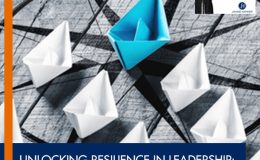
Businesses and organizations have been promoting diversity (and to a lesser extent equity, inclusion and belonging) in the workplace for a very long time. Practices have been in place to secure employees’ well-being and personal rights. But the sad part of the equation is that employees only see them as a one-off effort and end up leaving the company. Join our host, Janine Hamner Holman, in the first episode of this podcast, discusses the unseen subtlety of diversity in the workplace and the reasons why the workforce is continually entangled in this predicament. The workplace can be the second haven for employees. Listen in and learn more about organizational diversity from different perspectives.
HOST: Janine Hamner Holman | Janine@JandJCG.com | LinkedIn, Facebook, and Twitter | Subscribe to my Newsletter! Book me to Speak!
—
Listen to the podcast here:
The Unseen Subtlety Of Diversity In The Workplace
Welcome to the first episode of The Cost of Not Paying Attention. I’m your host, Janine Hamner Holman. I am excited to be with you!
I have been working on launching this show for close to a year, getting ready, writing stuff, meeting with people, and talking with them about being on the podcast. It’s been an amazing journey. I am excited that we are now getting it off the ground. In this show, we are going to look at all of the things that we are not paying attention to. Mostly in the world of work, but not exclusively, and what it costs us to not pay attention. What does it look like when we’re not paying attention to them? What the cost of that is to ourselves and organizations.
I am an organizational development consultant. What that means is that I work with organizations to help get all their people rowing in the same direction.
My friend Bisi Ezeolu recently said people do some funny things at work. Boy, do we ever!!
My work is figuring out what’s causing us to do those funny things and then solving whatever the cause is, or at the root level, so that people get engaged, we solve the problem, and the organization and its people can thrive.
Some of my clients have asked me to come in-house to a job that didn’t use to exist. It’s called a chief people officer. While there are things about that that sound like they would be super interesting to me, it’s not the impact that I want to make.
My goal, which I will not achieve in my lifetime, but I want to get as close as I can as possible, is to have the world of work be one in which everyone can thrive.
What beauty it is to have the world of work be one in which everyone can thrive. Share on XI am always looking to have the biggest impact that I can on the most people possible, hence, this show so that people can be more engaged in this conversation about the things that we’re not paying attention to so we can start paying attention to the ones that are important. Some of these things that we’re not paying attention to, like being deliberate about how our organizational culture develops, we know that we’re not paying attention to that.
Many of us are not paying very much attention to that one, although many of us are thinking about how we preserve or create a culture with so many workers being remote because it looks like that’s going to continue for a long time into our future. That’s a growing conversation that more people are paying attention to. Some of the things that we’re not paying attention to, we don’t even know we’re not paying attention to them. If you’re anything like me, that one gets me super curious. The voice in my head says, “If I don’t know that I need to pay attention to it, then maybe it’s not that important.” Maybe it’s not, or maybe it is…

Diversity In The Workplace: The problem is believing that diversity is an HR issue. The ones who promote diversity end up pushing away new hires who understand diversity.
For instance, do you know why most efforts on diversity, equity, and inclusion fail? Sometimes it’s because the organization wants to check a box to be able to say, “We’re doing something. Here’s our public statement. We embrace diversity and we stand up for everyone’s equality.” They never meant to do anything more than that, which is fine. If that’s what you mean to do, that’s fine.
But, for organizations that really want to create more diversity, equity and inclusion in their organizations, why are the majority of these attempts unsuccessful? We know that they’re unsuccessful because most diversity programs aren’t increasing diversity – and they’re definitely not increasing equity and inclusion. And we can forget about belonging!
According to the Harvard Business Review, despite a few new bells and whistles courtesy of big data, companies are doubling down on the same approaches that they’ve used since the 1960s, which often make things worse and not better. Isn’t that interesting? Many organizations have long relied on diversity training to reduce bias on the job, hiring tests and performance ratings to limit bias in recruitment and promotion, and grievance systems to give employees a way to challenge their managers.
A safe workplace is where you can speak up without being embarrassed rejected or punished. Share on XHere’s the problem. In the 1960s, these tools were designed to preempt lawsuits by policing managers’ thoughts and actions. They were never designed to increase diversity.
Think about that for a second.
A lot of the tools that organizations are using and have been using were never designed to increase diversity. Another challenge is that a lot of organizations think, “If we hire people who are different from the norm in our organization, then we’ve achieved diversity.” The problem is many of these people who are different from whatever that norm is inside the organization end up leaving. We constantly need to be rehiring and aren’t increasing our diversity, while at the same time, we are expending a lot of resources on this constant hiring.
The root problem there is believing that diversity, ultimately, is an HR issue.
The hiring part is just one step. And it should actually be the last step that we do.
All the stuff that we do before that are critically important steps.
The first step is to decide and then be really clear with everyone in your organization why we’re undertaking this effort. The next step can be to uncover the kinds of unconscious bias that may be happening in our organization. Like the things that we’re not paying attention to, what are we not seeing? What’s living in our unconscious, in our biases? Bias is one of those words that has a negative connotation. A friend of mine says, “If you have a brain, you have a bias,” which is true. Our brain has to sort out information quickly. It does it based on the things that we like, the things that we’re drawn to. That’s what a bias is. A bias isn’t good or bad. It just is.

Diversity In The Workplace: Psychological safety for employees is where people feel comfortable expressing their diversity of experience and thoughts and not be embarrassed, rejected or punished for speaking up.
What are the unconscious biases that are happening in our organizations? Once we uncover that and pull it out of our unconscious into our consciousness, then we can make a choice about it.
Next we get to go to work on building what’s become known as psychological safety for our people. In the world of work, psychological safety is a shared belief by members of a team that the team’s got their back. They are not going to embarrass you, reject you, or punish you for speaking up. It’s all about creating an internal organizational culture where people can tell each other the truth about things in a way that is both honest and respectful. It’s creating a climate in which we can be courageous and open, intellectually curious and humble, strong and enrolling. We know that others will be as well. We get to create these environments where people feel comfortable expressing their diversity of experience and thoughts.
It’s all about creating an internal organizational culture where people can tell each other the truth about things in a way that is both honest and respectful. We get to create environments where people feel comfortable expressing their diversity of experiences, thoughts, and where organizations both listen to and leverage that diversity. When organizations create an inclusive culture, they have more effective problem-solving, decision-making, and innovation leading to long-term profitability. I don’t know about you, but that’s what I’m interested in. Creating that for my organization and yours. We get to feel known for and seen for the unique value that you bring and our organizations valuing your perspectives. The most diverse organizations are also the most agile, profitable, innovative, productive, and have the easiest time recruiting and retaining top talent.
Organizations see burnout as a personal issue but in truth, it results from chronic workplace stress that has not been properly managed. Share on XThere’s a lot to be said about diversity, equity and inclusion that has nothing to do with political correctness. To get it right, it takes real work and commitment to create that internal, psychological safety. That’s just one of the issues that we’ll dive into more in-depth in season one of the show.
In addition, we’ll get to look at what happens when we forget to tell people “why” when we’re asking them to do something. We all know that this happens. We get focused on the what that we need to be done that we forget to tell people the why. As we will explore with the former Chief of Police of the City of Boston who was chief during the Boston Marathon bombing and the Occupy demonstrations, the why makes all the difference in the world.
We’ll also look at some organizations that are getting things right. In my conversation with Mark Pecota, the CEO of LaunchBoom, a global crowdfunding agency, he talks about their development in creating systems to ensure their employees’ well-being as they’ve been through a period of massive growth and expansion with an increasing number of people working remotely. Many of us have been dealing with the issue of remote workers. Mark points to the connection between our self-image that’s entwined in work productivity and how that can lead to burnout. Harvard Business Review has come out with a great and important five-series piece on burnout, its causes, and its impacts as well as how we can turn things around because that’s what we care about.

Diversity In The Workplace: The most diverse organizations are also the most agile, profitable, innovative, productive, and have the easiest time recruiting and retaining top talents.
We want to know why things happen, what it looks like when they happen, how we get to fix it, and how do we get to turn it around. One of the key takeaways from that series is that we have been treating “burnout” as a personal issue, as in this one person or this group of people are suffering from burnout. We focus on personal self-care and personal resilience, but here’s the thing that they found out. Burnout has been designated by the World Health Organization as a syndrome that results from chronic workplace stress that has not been successfully managed.
What this means is it’s more than a personal wellness issue. It’s an organizational wellness issue, which means that it requires organizational development solutions. Talk about something to which we have not been paying attention and the cost is in both our personal health and our organizational health.
Several universities got together, including Berkeley and Rutgers, to determine the main causes of burnout. The main causes of burnout are unsustainable workload, a perceived lack of control, an insufficient reward for effort, not for work product, lack of a supportive community, lack of fairness, and mismatched values and skills. That’s a lot to unpack, and we’re going to do that in an upcoming episode.
One of my completely nerdy passions is brain science. Back in the day, when I was in school, I hated the “hard sciences,” Chemistry, Biology, and Physics. In fact, I found them quite hard. Fast forward, many years ago, I got totally into neuroscience. What’s going on in that gray matter inside our heads, and why it sometimes leads us to outcomes that we don’t want. I’m going to nerd out about that. I hope you join me and nerd out about it too. We are going to talk about how we listen, why we don’t listen, and what we do instead of listening, which often happens when we think we’re listening.
Spoiler alert, we’re not listening most of the time. We’ll talk about the epidemic of incivility that’s impacting many organizations and some tools to address everything from microaggressions to outright toxic behavior. We’re going to look at why soft skills, which I call the critical skills, are darn hard, the role of emotional intelligence in the workplace and how more of us can thrive at work, which is my overriding passion. It is going to be an amazing season. I look forward to having you join me on this journey. That’s a wrap on this first episode. Remember, great leaders, make great teams. Until next time.
Important Links:
- LaunchBoom
- Burnout – Harvard Business Review article





